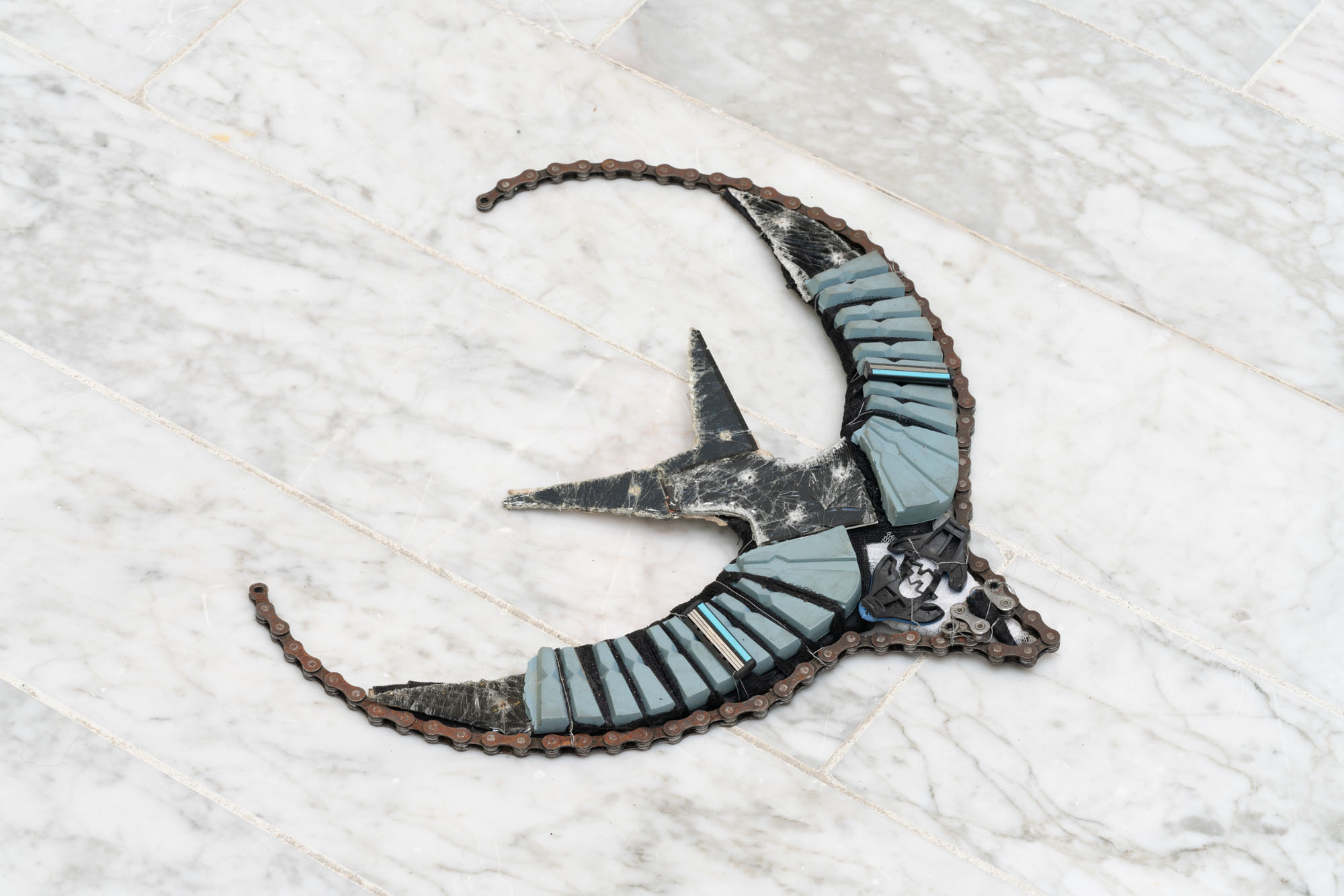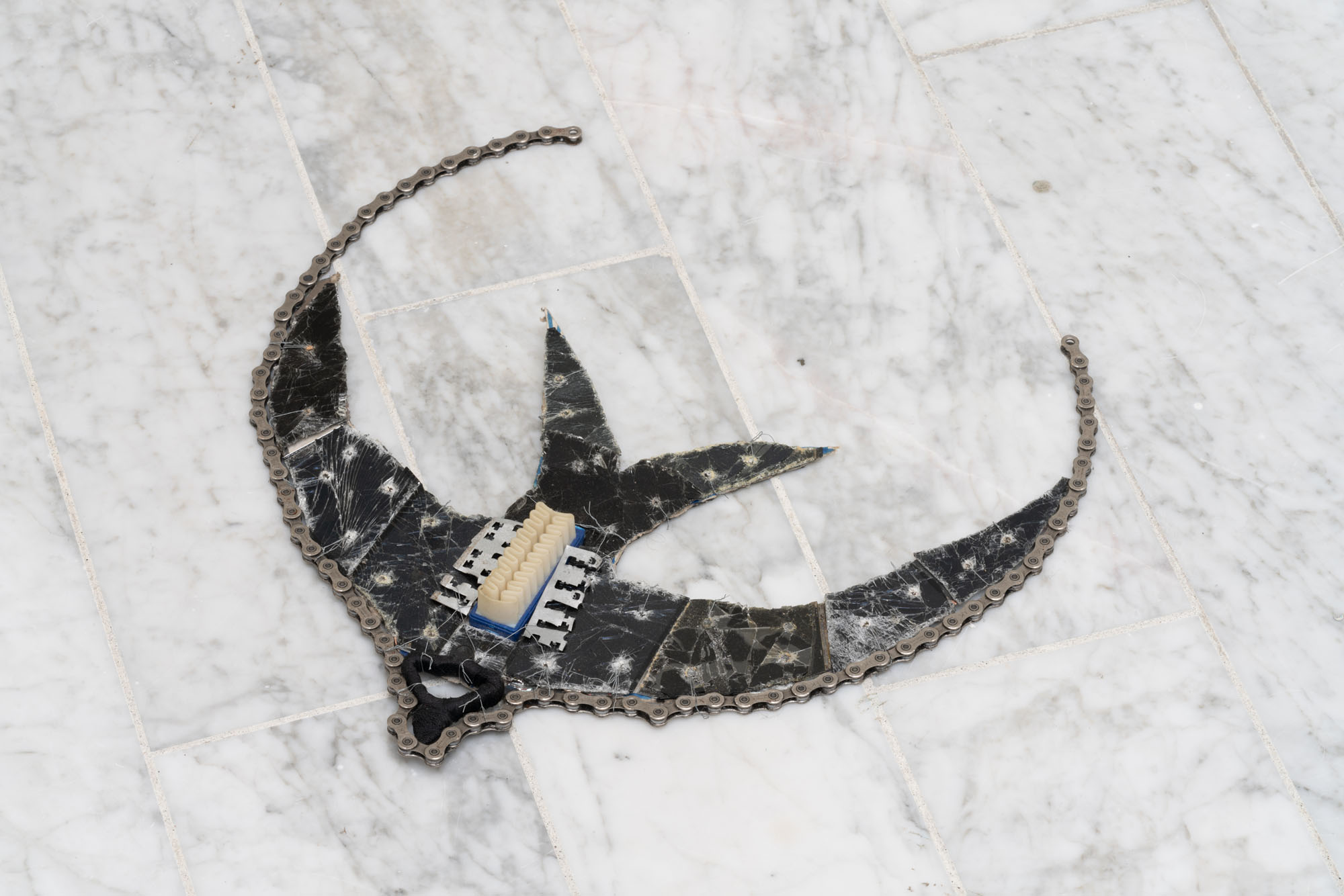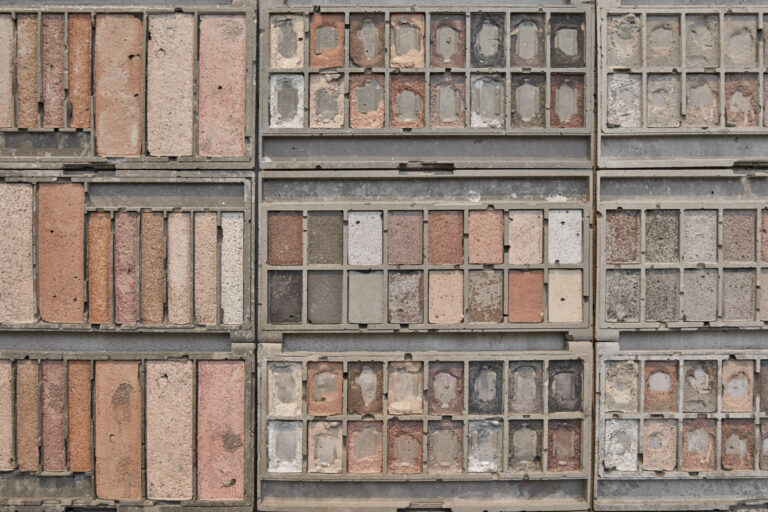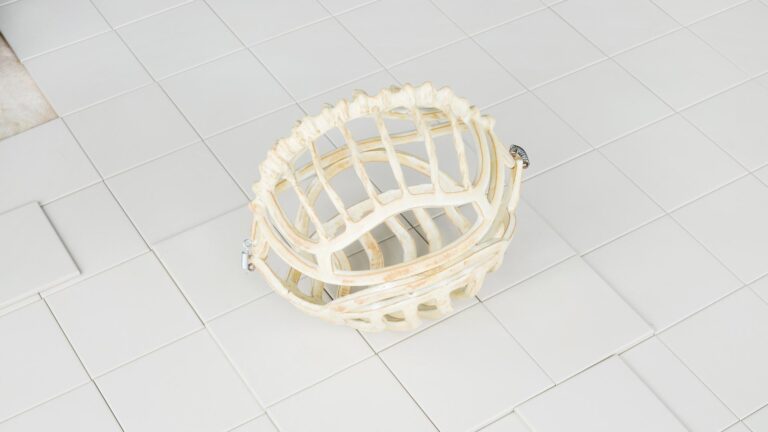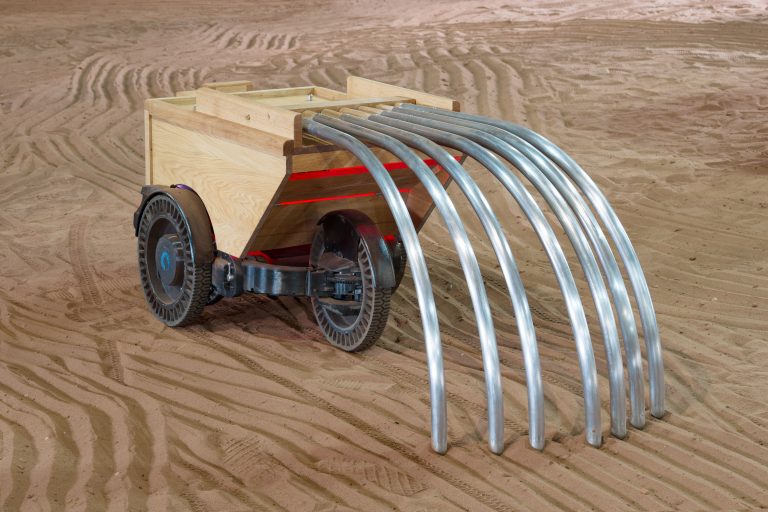Artists: Emilie Alstrup, Stine Deja, Estrid Lutz, Anna Solal, Jon Rafman
Exhibition title: Biotechnosphere
Venue: Tranen Contemporary Art Center, Hellerup, Denmark
Date: August 28 – November 14, 2019
Photography: all images copyright and courtesy of the artists and Tranen Contemporary Art Center
Biotechnosphere is the first group show at Tranen in six years. The works of the selected artists present a major current in contemporary art. More and more artists address technology as if it were living matter – and living matter as if it were technology. Nature from which mankind originates is still more difficult to tell from the culture that mankind creates. A new landscape surfaces, one that’s changing so rapidly it’s close to impossible to capture in its moment. Instead, a range of works is presented that bear witness to a great transformation. The works bear witness to what is about to perish, what is about to emerge and what is about to take on entirely new forms. Technology is no longer merely mechanical objects. Biology not merely animals and plants. Both are equally to be thought of as spheres, which envelop the globe and increasingly seem indistinguishable from one another.
The biosphere is the sphere of life. It finds its origins in microscopic single-celled organisms. For over 3,8 billion years, life on earth has evolved into complex ecosystems of plants, animals, fungi, bacteria, and other lifeforms. But especially during the 20th century, the biosphere has been subject to dramatic change. A new sphere, the so-called technosphere, has grown forth at unheard of speed. The technosphere is – according to geologist and engineer Peter Haff’s now widespread definition – everything that humans have created from tools and machines to cities and infrastructures to agriculture, forestry, and waste. Certain scientists call it a “parasite on the biosphere”; a guest, which one fears will take the life of its host and, as a consequence, also itself. The technosphere is today estimated to be both much more heavy and diverse than the biosphere. Calculations assess the technosphere to weigh around 30 trillion tons. Other estimates suggest that the number of technological devices is much higher than the diversity of the biosphere, which according to one study accounts for about 8.7 million animal, plant and fungus species.
In 1926, when the founder of biogeochemistry, Vladimir Vernadsky, published the first comprehensive theory of the biosphere, this was the sphere he thought set earth apart from all other, known planets. Today, less than 100 years later, the technosphere has arguably grown even bigger. Its light is now seen from space thanks to satellites, which also mark its ongoing expansion. But the technosphere is not a sphere apart. It is inextricably entangled in the biosphere. Humans and domesticated animals today constitute 97 percent of the total mass of all animals on earth. Hence, there is only 3 percent wild animals left. In Denmark, which is the most cultivated country in the world alongside Bangladesh, agriculture covers 57 % of the land.
Certain voices such as biologist Edward O. Wilson argues that the biosphere must be disconnected from the technosphere: “I am convinced that only by setting aside half the planet in reserve, or more, can we save the living part of the environment and achieve the stabilization required for our own survival.” Others instead push for a new and different kind of fusion of biology and technology. One is MIT entrepreneur Caleb Harper, who is currently working on developing so-called Personal Food Computers. Through a network of interconnected users, who exchange data about vegetables they grow in enclosed biospheres in computers, he envisions a CO2 neutral world, where everyone produces and consumes the food they eat.
The artists in Biotechnosphere present neither solutions nor plans of action. Rather, their works give shape to visions of biological and technological processes that clash and coalesce. In French artist Anna Solal’s floor works, birds seem to rise from stains from a big coffee cup. In her drawings, a beautiful stretch of life-giving blue sky is enclosed by smashed smartphone screens and bicycle chains. In a similar vein, in the works by Estrid Lutz from Bosnia-Hercegovina, earth is a dump that serves as a breeding ground for new composite lifeforms. In her wall works, materials from the automotive, satellite and communication industries converge and merge with imagery of microscopic life, snakeskin, and lizards. Layers of glow-in-the-dark paint ooze of a bygone world re-animated by life and spirit. In Danish artist Stine Deja’s animations on the floor creatures part biological organs, part technological prosthesis stand tall, while in another Danish artist, Emilie Alstrup’s prints on acrylic glass, a hybrid being twists and turns to the point where its constituent parts start to blur. In these works we do not just confront human beings in transformation; beings that technologically adapt to a rapidly changing world. It’s as if one is also about to lose sight of mankind. In Canadian artist Jon Rafman’s 8 min long video, we find ourselves in man-made world, where there aren’t any humans left, apparently, only technological infrastructures. A voice speaks, among others about not knowing why it’s speaking. It sounds like a digital voice, perhaps that of an artificial intelligence. Perhaps the film stages the scenario of the so-called singularity; the point in the future, when artificial intelligence will surpass human intelligence; a point beyond which our limited intelligence cannot comprehend what will happen.
We can compute the state and development of the bio- and technosphere. But we cannot figure out what will happen. It is among other things such uncertainty that nourishes the artistic expressions on display in Biotechnosphere.
The exhibition is accompanied by a selection of fiction and non-fiction books curated by Toke Lykkeberg.
Toke Lykkeberg
Director of Tranen
Biotechnosphere is the fifth exhibition in Tranen’s program about extemporary art. The focus is on contemporary art that is not primarily focused on our contemporary condition. When everything from climate to technology evolves at ever greater pace, the present becomes ephemeral and intangible. The present starts to shrink. Meanwhile, our knowledge of the past increases. Speculations about the future abound. As part of this development, much art is no longer contemporary, which literally means ‘with time.’ Instead, art is rather ‘extemporary, i.e. ‘out of time’.
The exhibition is generously supported by Det Obelske Familiefond and The Danish Arts Council.
Biotechnosphere, 2019, exhibition view, Tranen Contemporary Art Center
Biotechnosphere, 2019, exhibition view, Tranen Contemporary Art Center
Biotechnosphere, 2019, exhibition view, Tranen Contemporary Art Center
Biotechnosphere, 2019, exhibition view, Tranen Contemporary Art Center
Biotechnosphere, 2019, exhibition view, Tranen Contemporary Art Center
Biotechnosphere, 2019, exhibition view, Tranen Contemporary Art Center
Estrid Lutz, Ecdysis III, 2018, honeycomb aluminum, epoxy resin, photoluminescence pigments, aluminum wire, 2 pieces, ca. 85 x 82 cm
Estrid Lutz, Ecdysis III, 2018, honeycomb aluminum, epoxy resin, photoluminescence pigments, aluminum wire, 2 pieces, ca. 85 x 82 cm
Estrid Lutz, Ecdysis II, 2018, honeycomb aluminum, epoxy resin, photoluminescent pigments, aluminum wire, 2 pieces, ca. 130 x 95 cm
Estrid Lutz, Ecdysis II, 2018, honeycomb aluminum, epoxy resin, photoluminescent pigments, aluminum wire, 2 pieces, ca. 130 x 95 cm
Jon Rafman, SHADOWBANNED, 2018, Single-channel HD video , 7’57 min, Courtesy of the artist
Emilie Alstrup, Parahuman, 2019, acrylic on plexiglass
Biotechnosphere, 2019, exhibition view, Tranen Contemporary Art Center
Biotechnosphere, 2019, exhibition view, Tranen Contemporary Art Center
Biotechnosphere, 2019, exhibition view, Tranen Contemporary Art Center
Anna Solal, AFTERNOON CLOUDS, 2018, Broken smartphone screens, bike chains, ropes, tulle, metal thread, colored pencil on paper, plexiglass, plastic supermarket box grid, 64 x 50 x 1 cm
Anna Solal, MORNING CLOUDS, 2018, Colored pencil on paper, tulle, bike chains, broken smart phone screens, plastic supermarket box grid, metal thread, plexiglass, 65 x 48 x 1,5 cm
Anna Solal, CUP WITH STAINS, 2018, Broken smart phone screens, shoe parts, razor, massage stick, plastic, ropes, metal thread, tulle, bike chains, metal parts, Installation, Dimensions variable
Anna Solal, CUP WITH STAINS, 2018, Broken smart phone screens, shoe parts, razor, massage stick, plastic, ropes, metal thread, tulle, bike chains, metal parts, Installation, Dimensions variable
Anna Solal, CUP WITH STAINS, 2018, Broken smart phone screens, shoe parts, razor, massage stick, plastic, ropes, metal thread, tulle, bike chains, metal parts, Installation, Dimensions variable
Anna Solal, CUP WITH STAINS, 2018, Broken smart phone screens, shoe parts, razor, massage stick, plastic, ropes, metal thread, tulle, bike chains, metal parts, Installation, Dimensions variable
Anna Solal, CUP WITH STAINS, 2018, Broken smart phone screens, shoe parts, razor, massage stick, plastic, ropes, metal thread, tulle, bike chains, metal parts, Installation, Dimensions variable
Anna Solal, CUP WITH STAINS, 2018, Broken smart phone screens, shoe parts, razor, massage stick, plastic, ropes, metal thread, tulle, bike chains, metal parts, Installation, Dimensions variable
Biotechnosphere, 2019, exhibition view, Tranen Contemporary Art Center
Stine Deja, Hard Core, Soft Bodies, 2018, installation and video
Stine Deja, Hard Core, Soft Bodies, 2018, installation and video




















